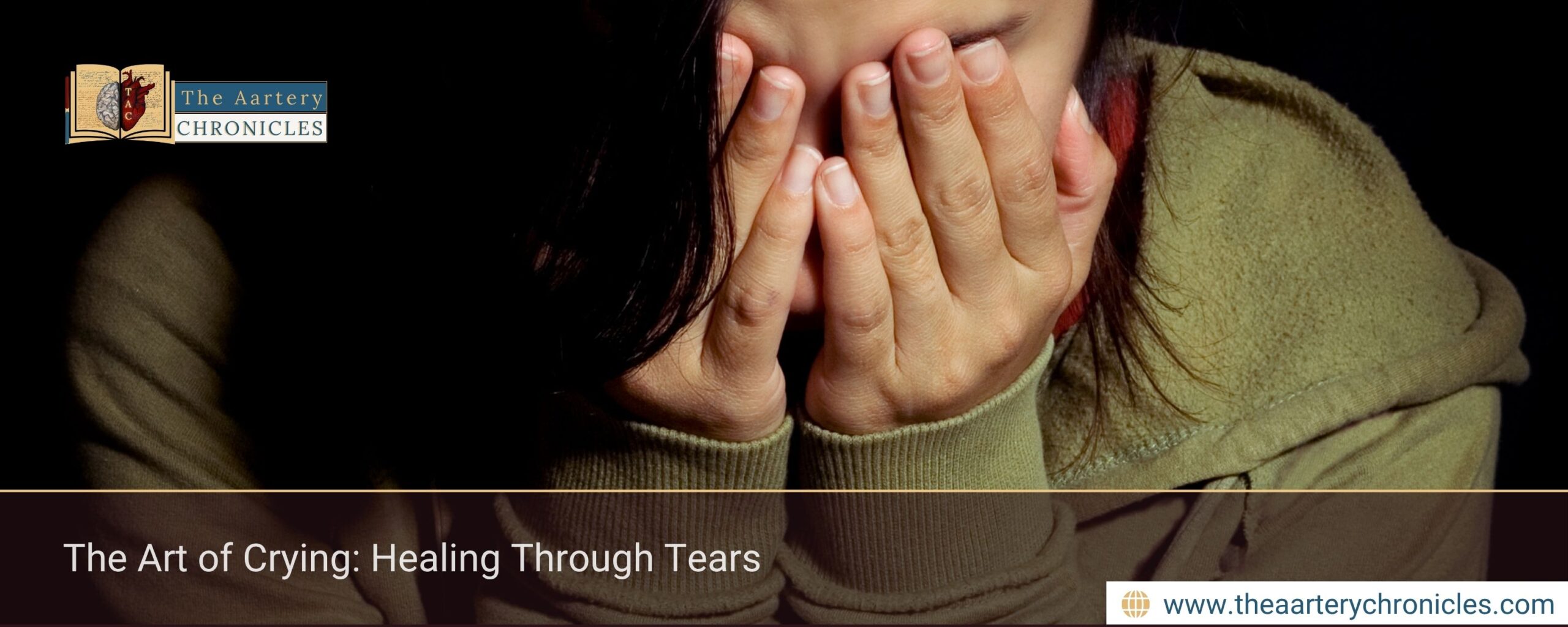

Tears That Heal: How Crying Heals the Mind
Summary: Crying is not weakness; it’s nature’s emotional detox. This article examines the various types of tears, the science behind crying, its mental and physical health benefits, and the growing trend of cryotherapy and clubs that promote emotional healing worldwide.
Crying is a way to let go and release all the pent-up emotions that we have hidden from ourselves. Be it dealing with the grief of losing a loved one, a heartbreak, not being considered for that well-deserved promotion, bypassing all the blood, sweat and tears you put into your job, being parents of children who live away from you; being misunderstood by friends; watching an emotional film; fighting an illness; and so on.
The Art of Crying: Healing Through Tears
When we cry, it releases a salty fluid containing protein, water, mucus and oil (known as tears) from the lacrimal glands in the upper, outer region of our eye, that flows down the surface of our eye and across our face.
“There must be something strangely sacred in salt. It is in our tears and in the sea.”
Kahlil Gibran Tweet
Types of Tears
There are three types of tears
1. Basal Tears
These are forever present in our eyes that prevent our eyes from drying up completely. An average of 5 to 10 ounces of basal tears are produced by our body daily. These tears drain out via our nasal cavity, which accounts for the runny nose after a good cry.
2. Reflex Tears
These tears protect our eyes from irritants like
- Smoke
- Onions
- Dusty winds
When we chop onions, it releases an enzyme, lachrymatory-factor synthase and converts the amino acids in the onion to sulfenic acid, transforming into a substance called syn-propanethial-S-oxide, which drifts into our face and irritates the lachrymal glands in our eyes, making our tears fall. In other words, the sensory nerves of our cornea signal this irritation to the brain stem, which immediately releases hormones in our eyelids, which produce tears to get rid of the irritant. Something like a reflex action.
3. Emotional Tears
These are tears that originate in the cerebrum, where emotions like sadness etc., are lodged. This triggers the endocrine system to release hormones in the ocular area, leading to the formation of tears. This is a way to release any emotions (release of stress hormones) that have been building up inside us, thereby eliminating toxins and waste products
Research and Studies
Analysis of tears has shown that reflex tears are composed of 98% water, whereas emotional tears contain chemicals like
- A protein named prolactin (known to control the production of breast milk).
- Adrenocorticotropic hormones, which are common and indicative of high stress
- An endorphin named leucine-enkephalin, known to reduce pain and improve our mood
More research is required on this aspect.
There are some studies which show that holding back emotional tears may lead to cardiac issues and hypertension.
Psychologists advise grieving people to cry and relieve themselves of their grief, rather than holding back their tears and putting up a brave front.
10 Benefits of Crying
Research shows that crying is beneficial for mind and body wellness. It activates the parasympathetic nervous system, which is essential for rest and repair of our body.
- SELF-SOOTHING: Crying has a soothing effect on us, helping us manage our emotions better, calming us and reducing our distress. According to a 2014 study, crying activates the parasympathetic nervous system, thereby calming and soothing us.
- SOCIAL SUPPORT: Crying helps us generate support from those around us, making it an interpersonal or social benefit. When we cry, those around us offer us tissues, say soothing words, or just be the shoulder to cry on.
- FEEL GOOD FACTOR: Crying makes us feel good as it releases hormones like oxytocin and endorphins (feel-good chemicals), which alleviate physical and emotional pain.
- IMPROVES MOOD: Crying improves our mood and makes us feel better, as it releases hormones like oxytocin and endorphins, which are the ‘feel-good chemicals’.
- EXPELS TOXINS: Crying reduces the levels of stress hormones and chemicals present in our body, thereby alleviating our stress and expelling toxins.
- SAFE EYES: Crying helps to kill the bacteria and keep our eyes clean and safe. Tears contain a fluid called lysozyme, which has potent anti-microbial properties to reduce risks of bioterror agents like anthrax.
- BETTER VISION: When we blink, basal tears are released, keeping our eyes moist and preventing the mucous membrane from drying out completely. Basal tears have a lubricating effect and improve our vision. Dry eyes lead to blurry vision.
- INDUCES SLEEP: Crying helps babies sleep better. After crying, adults feel calmer, their mood is improved, and their pain is reduced, all of which may make them sleep easily.
- THERAPEUTIC EFFECT: Crying is therapeutic as it restores our mind and body balance by activating the parasympathetic nervous system, lowering the heart rate, lowering the breathing rate and lowering blood pressure levels in our body. It removes negative energy and emotions and helps us heal. Psychologists suggest crying as a form of therapy, as it prevents psychological damage from the repression of tears/emotions.
- PHYSIOLOGICAL EFFECT: Tension leads to the furrowing of the brow, clenched jaw, pressure around the forehead, and tightening or redness of the face. Crying releases and reduces the tense facial muscles, making us look better and stress-free.

What makes us cry?
Crying occurs due to many reasons:
- REFLEX: Crying is like a reflex action that protects us from any eye irritants like smoke, strong wind, eye injuries, and facial pain
- EMOTIONS: Emotions like extreme happiness, sadness, laughter, sudden bouts of anger, frustration, fear, emotional memories or life events
- FATIGUE: Fatigue or lack of sleep leads to an inability to cope with emotions
- HORMONES: Some hormones may impact if we feel like crying (prolactin) or not (testosterone).
- RELATIONSHIPS : Maintaining relationships may lead to emotional crying or make us feel comfortable crying in the presence of loved ones.
- CULTURE: Certain cultures and upbringing do not promote crying and it is seen as a sign of weakness, which may impact whether we can cry or not.
- NEUROLOGICAL CONDITIONS: Certain neurological conditions like those related to the brain or nerves may trigger bouts of crying. E.g. migraines, cluster headaches, multiple sclerosis, traumatic brain injuries or stroke.
- PSYCHOLOGICAL CONDITONS: Certain psychological health conditions may cause crying or poor control over emotions may lead to prolonged periods of crying.
- ATTENTION: Babies cry as they want attention – nappy changing time or feeding time, tummy ache time, or missing mommy time, as their communication skills are yet to develop.
“After a good cry, I feel lighter—like my heart took a deep breath.”
Vandana Kaushik Tweet
Crying Therapy And Cry Clubs: Trending Now
Ruikatsu (in Japanese, Rui means tears, katsu means activity) is a Japanese wellness practice that encourages people to cry intentionally and release their pent-up emotions. The origin of Ruikatsu can be traced back to 2013 when a Japanese entrepreneur, Hiroki Terai, observed that intentional crying “helped people feel emotionally unburdened”.
Ruikatasu is an organized gathering of people who watch emotional films, listen to touching stories, read letters, or participate in any other emotional activity. Sessions are often led by professional “tear therapists” who guide the participants through the process. Japan is known for its traditional values, emotional restraint and stoicism in public and professional gatherings. Ruikatasu is a way which makes them manage their emotions in a structured and dignified manner.
Taking the example of Japan, Crying Clubs have arrived in India too, in cities like Delhi, Bengaluru, Surat, Hyderabad and Mumbai. The Cry Club in Khar, Mumbai has opened its doors for those seeking relief from unspoken feelings.
In a Crying Club, participants are admitted for a fee. The ambience is calm and supportive, with soft music playing in the background. There is an array of warm drinks and plenty of tissues. Participants speak in all their vulnerability, are listened to by the others, are not judged, are not advised or interrupted and are accepted as they are. Crying, ranting, bawling, and silently reflecting are all done here. It takes courage to do this – crying in the presence of strangers! The club teaches how to express emotions rather than suppressing them.
Who would have thought that a simple natural phenomenon like crying would evolve this way!
Men Don’t Cry
In India, it is considered a sign of weakness if a man cries. Well, this is far from the truth. Men and women both go through emotional times and need an outlet to release their stress and manage their emotions by crying, which is the best solution, irrespective of caste, creed, race, nationality or sex. It is time that this “men don’t cry” mentality be done away with.
Crying is a natural, human phenomenon, a sign of strength, a sign of putting wellness above anything else, a sign of accepting and moving on in life, a sign of gaining clarity, a sign of bravery, and above all, a sign of being human.
“Free your mind, and the rest will follow” – sang En Vogue.
So, let those tears flow, release yourself from your emotional shackles and embrace freedom. Experience the joy of crying and become a stronger person.
Crying as a Path to Healing
Tears are more than just drops of emotion; they’re a biological language of healing. Crying lowers your heart rate, releases stress hormones, and restores emotional equilibrium. When you let yourself cry, you’re allowing your mind and body to communicate, cleanse, and recalibrate.
Next time you feel that familiar sting in your eyes, don’t hold back. Let your tears fall—they’re your body’s way of saying, “I’m healing.”
[1] https://my.clevelandclinic.org/health/articles/crying
[2] https://www.medicalnewstoday.com/articles/319631
[3] Various online media reports
- Rupal Sonpal
- Blogs,Health Guide
- 22 October 2025
- 11:00








